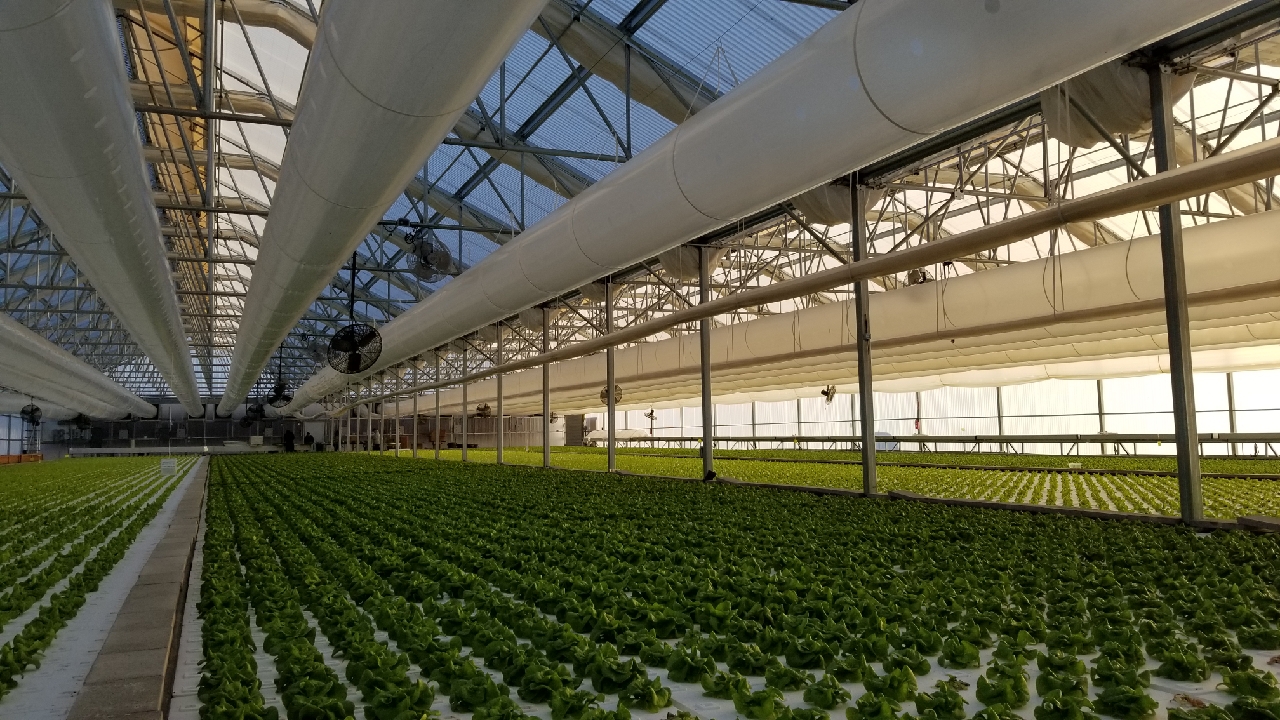According to studies by the New Mexico State Agricultural Department, it was found that positive pressure cooling provides uniform distribution of cool air throughout the greenhouse. Delivered air is substantially cooler than with negative pressure systems by approximately 5-10 degrees. And when installed with thermal sensor and Agra Tech motor managers, the energy savings can be up to 50%.
While simple in concept, positive pressure cooling is actually an engineering challenge. Positive pressure cooling for the greenhouse is nothing new. As a matter of fact, it has been used for over forty years but its use has been limited to small areas and special applications. The engineering challenge is to make it effective in large areas for commercial growers. The main problem to overcome is the massive solar heat gain inside a greenhouse. Normally greenhouse cooling is achieved by moving large volumes of air. This solution conflicts with the main benefit of positive pressure cooling, restricting insect entry into the greenhouse environment. It is a catch 22 engineering problem. Good cooling requires moving large amounts of air. All that air brings many insects into the greenhouse.
There are three basic greenhouse-cooling systems: positive pressure, negative pressure and natural ventilation. Negative pressure systems generally pull all the air out of a greenhouse once a minute with fans and pads located on opposite walls. Solar heat gain will cause the air temperature to rise as it travels from wall to wall. In some cases it may increase 20 degrees from pads to fans. And more insects are sucked in every minute. The best natural ventilation system is only capable of matching the outside temperature and then all roofs and walls are open to insect infestation. Positive pressure systems force cool air into the greenhouse. The new cool air settles to the ground. The old air is warmed from the sun as it rises. It exits the ridge vents hot and far away from the crops.
Historically positive pressure systems used small packaged units. Low airflow and small pad areas limited their cooling performance. They were used mostly for research facilities and high value crops where a clean environment was more important than cooling and where high operating costs could be justified.
Agra Tech engineers have developed Agra Kool II, a system that overcomes the limitations of past positive pressure cooling systems making it a reliable cooling alternative for most growers. A steel covered frame is attached to one of the greenhouse walls. A standard cooling pad system is mounted to the outside. High volume jet-fans pull air through the pads and insect screens and force it into the greenhouse through special convection tubes. Integrated pressure sensitive ridge vents maintain pressure and allow heat to exit.
At Agra Tech, we have been on the technological edge of developing positive pressure greenhouse cooling for two decades. No other greenhouse manufacturer knows more about the engineering headaches inherent with positive pressure systems than us. Growers have been relentless in their need for new and improved greenhouse cooling systems. So have we.

We work closely with Jim Bergantz, our Agra Tech sales rep and he handles everything well for us. We’re extremely happy working with Agra Tech and that’s why we’ve bought so many greenhouses from them. If we have questions or need something above and beyond from these people, they don’t hesitate to come through for us. Their customer service is exceptional across the board. We’ve worked with Agra Tech on so many greenhouses that we’ve got it down to a science by now.
Read article: Growing Demand at Woods Transplants
Woods Transplants
Mark Woods
Gustine, CA